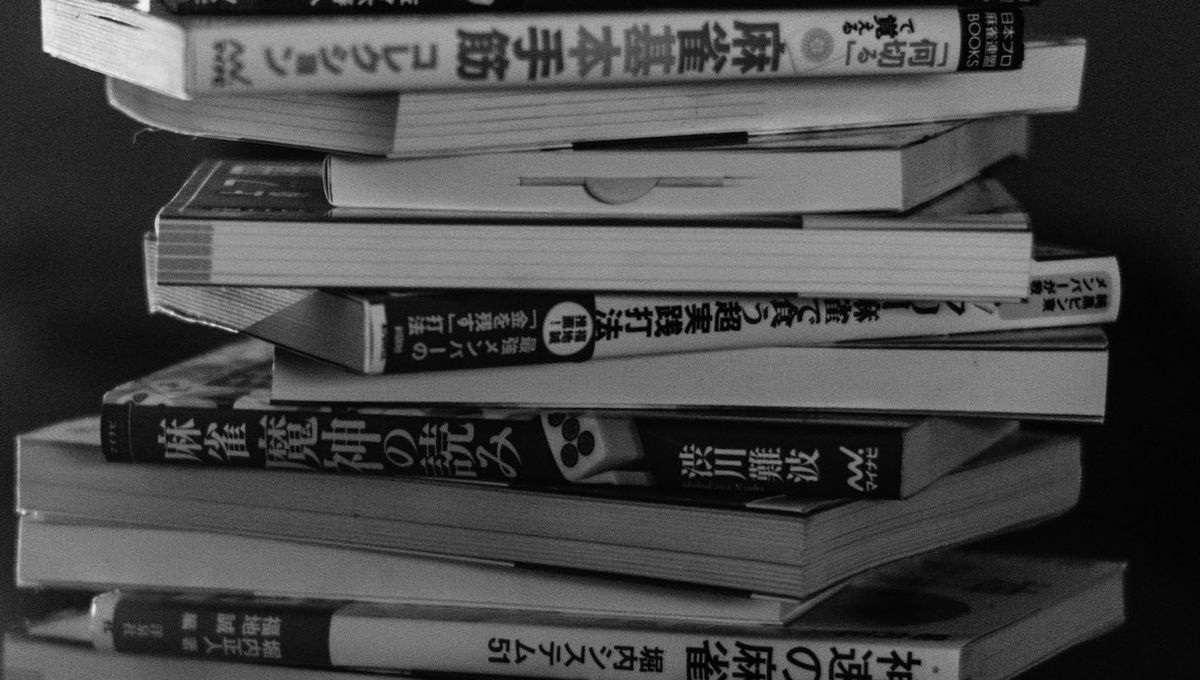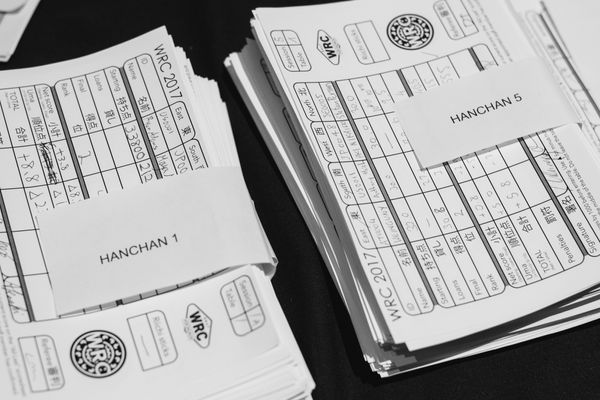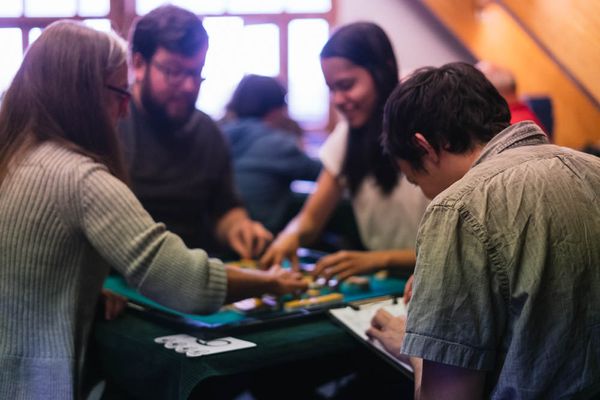Tile Efficiency 101 (Part 2)

The last post on tile efficiency was kind of basic, so today's article now introduces the concepts we are going to use in the future articles. Especially, Shan-Ten (how many away), Uke-Ire (the amount of tiles that move you one shanten closer to tenpai) and Good Shape Evolution (when your hand will evolve towards good shape). So, enjoy.
Source: http://beginners.biz/h_02.htmlUseful Tiles and Tile Numbers
Mahjong is a game where you systematically discard once and again an unwanted tile from your hand. Last time, I said that selecting your discard prioritizing the easy win is basic.So, what should we select to discard concretely...
1.Number of tiles and probability
Ex1:![]()
![]()
![]()
![]()
![]()
![]()
![]()
![]()
![]()
![]()
![]()
![]()
![]()
![]()
In ex1, as long as ![]() isn't very dangerous, we should discard
isn't very dangerous, we should discard![]() .
.
Let's try to think it over. Why is it a mistake to discard ![]() or
or ![]() ?
?
Of course, it's because discarding ![]() leaves us with a better wait.
leaves us with a better wait.
Let's try to compare them virtually.
![]()
![]()
![]()
![]()
![]()
![]()
![]()
![]()
![]()
![]()
![]()
![]()
![]() Wait:
Wait: ![]()
![]()
![]()
![]()
![]()
![]()
![]()
![]()
![]()
![]()
![]()
![]()
![]()
![]()
![]() Wait:
Wait: ![]()
![]()
If you consider the number of winning tiles, the former has 7 tiles, while the latter has 3.
Of course, since some of them might be in the hands of our opponents or in the dead wall, in reality,
you should naturally wait on 7 tiles, since it's not like if you wait on 3 tiles they'll be alive.
There are cases where there aren't any ![]()
![]() remaining as well.
remaining as well.
However, there is practically no way for us to tell how many tiles are remaning on the live wall.
That is because we are not psychic.
In reality, when comparing whether to wait on 7 or 3 tiles, judging that the ![]()
![]() wait is more effective is good.
wait is more effective is good.
"The more tiles you wait on, the better your wait is" is a basic concept in mahjong.
Ignoring this basic concept, it is not possible to win at mahjong.
Thewait has more tiles.
= It's more likely we'll win on
.
= It's more advantageous to wait on
.
It is important to play mahjong with this mindset.
Mahjong is not a game where you compete to see who has a better sixth sense, it's a game where you compete to better evaluate advantages and disadvantages.
2.Number of uke-ire
In example one, we evaluated a tenpai hand, but if we also evaluate a hand that is not tenpai and compare whether there are too many or too few tiles, what to discard should become an obvious choice.(...) -- 3 shanten --- 2 shanten ------- 1 shanten ------------ tenpai --------------------- Win
Let's look at this graphic once again.
Since there is a large gap of distance until the win, it is hard to find the fastest way.
First, let's find the fastest route to the next step (2shanten, 1shanten, etc), and think about the fastest route possible towards tenpai.
Using the number of tiles, the easiest wait to measure how close to the win the hand is, is to count and compare how many tiles will decrease the number of shanten.
Ex2
![]()
![]()
![]()
![]()
![]()
![]()
![]()
![]()
![]()
![]()
![]()
![]()
![]()
Ex2 is a hand 2shanten. Let's count how many tiles transform it into 1shanten.
![]()
![]()
![]()
![]()
![]()
![]()
![]() that's 7 types and 23 tiles
that's 7 types and 23 tiles
<<(remember to substract the tiles already in your hand [1m, 4p, 2s] or visible on the board).>>
This is the number of uke-ire towards 1shanten. This is, the uke-ire.
Ex3
![]()
![]()
![]()
![]()
![]()
![]()
![]()
![]()
![]()
![]()
![]()
![]()
![]()
Ex3 is very similar to Ex2, but since it is also 2shanten or 2-away from chiitoitsu/Seven Pairs, the uke-ire is:
![]()
![]()
![]()
![]()
![]()
![]()
![]()
![]()
![]()
![]()
![]()
![]()
![]() that's 13 types and 35 tiles.
that's 13 types and 35 tiles.
Its ukeire is far wider than Ex2, so it is clear that its shape is better than Ex2.
In this way, counting the ukeire of the hand, it is possible to measure a hand's merit with numbers.
We will be using the value of uke-ire in the following lessons.
3.Evolving into good shape
![]()
![]()
![]()
![]()
![]()
![]()
![]()
![]()
![]()
![]()
![]()
![]()
![]() tsumo:
tsumo: ![]()
If we think about the earlier concepts, by cutting ![]() when we draw
when we draw ![]() , the hand is still 2shanten, but since the uke-ire increases, we must think of
, the hand is still 2shanten, but since the uke-ire increases, we must think of ![]() as a useful tile as well.
as a useful tile as well.
Useful tiles either:
A : Decrease the number of shanten (uke-ire)
B : Increase the number of uke-ire (good shape evolution)
one or both things.
Ex4
![]()
![]()
![]()
![]()
![]()
![]()
![]()
![]()
![]()
![]() (pon)
(pon) ![]()
![]()
![]() tsumo:
tsumo: ![]()
Ex4 is a decission about which wait to take.
With the current shanpon wait and even if we discard ![]() for a kanchan, the uke-ire is the same number: 4 tiles. In that case, let's think about evolution towards good shape.
for a kanchan, the uke-ire is the same number: 4 tiles. In that case, let's think about evolution towards good shape.
![]()
![]()
![]()
![]()
![]()
![]()
![]() drawing
drawing ![]()
![]() number of tiles UP.
number of tiles UP.
![]()
![]()
![]()
![]()
![]()
![]()
![]() drawing
drawing ![]() number of tiles UP.
number of tiles UP.
Since it can also improve to a three-sided-wait, keeping the shanpon wait is correct.
In cases like these where the uke-ire is the same, we use the technique of comparing evolution towards good shape.
The important thing here is uke-ire number has more value than good shape evolution number.
First of all comparing the number of uke-ire before anything else is basic tile efficiency.
A : Decrease the number of shanten (uke-ire )
B : Increase the number of uke-ire (good shape evolution)
Rarely, there are also people who give A and B the same value, and people who sum and compare A+B.
Since it's very simple to get confused, let's be careful.



